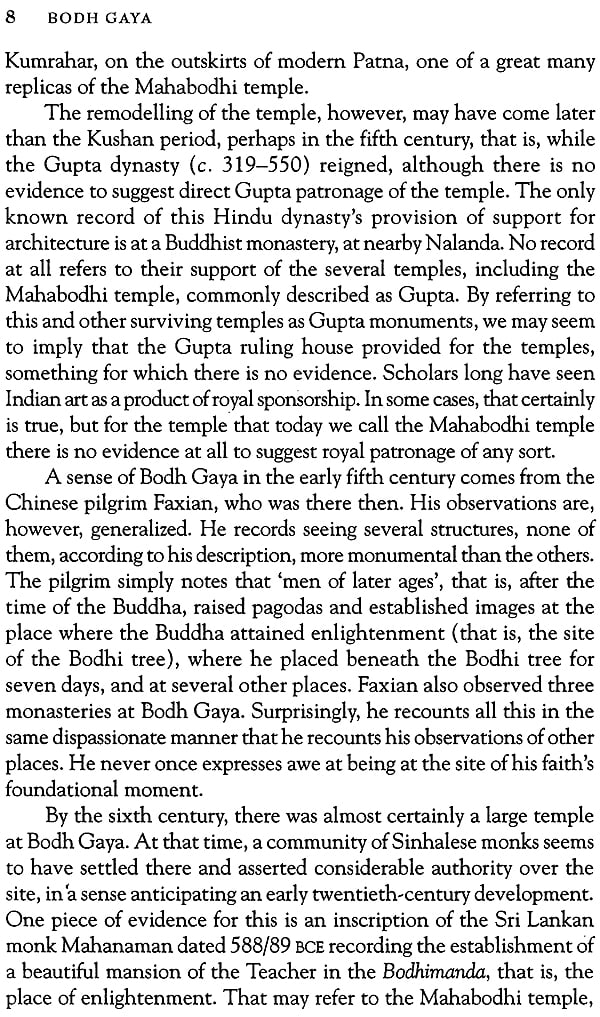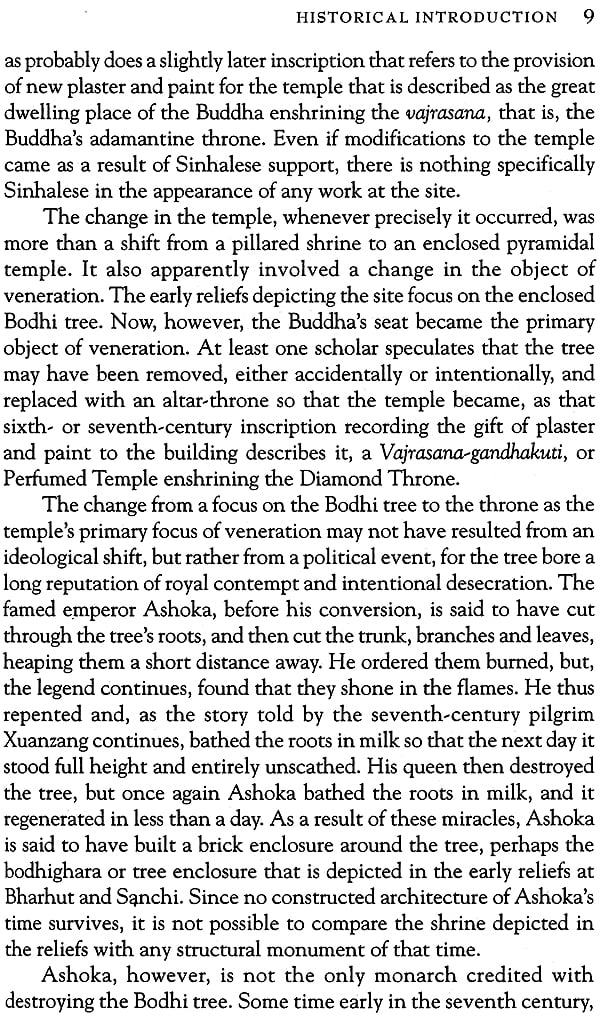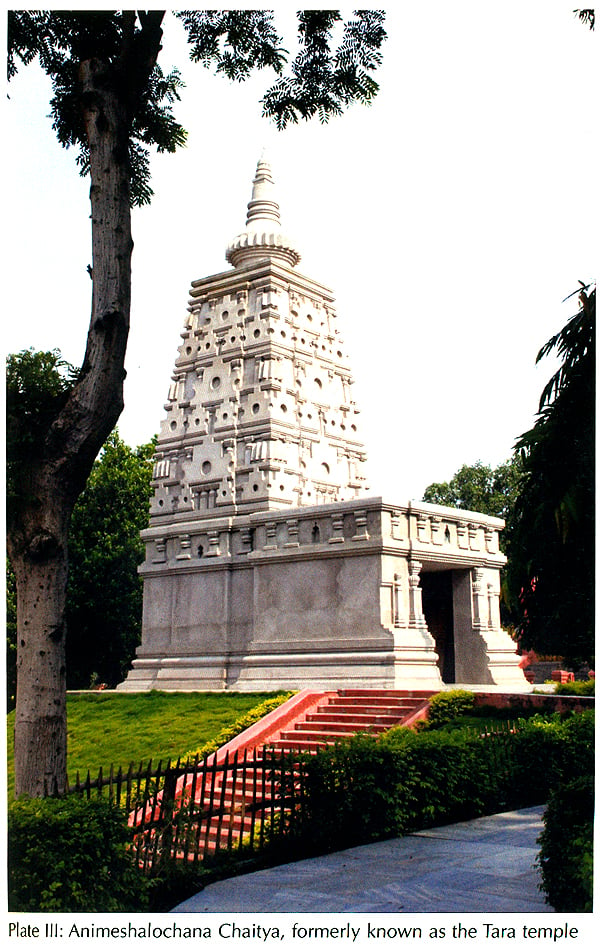
Bodh Gaya (Monumental Legacy)
Book Specification
| Item Code: | NAG305 |
| Author: | Frederick M. Asher |
| Publisher: | Oxford University Press, New Delhi |
| Language: | English |
| Edition: | 2011 |
| ISBN: | 9780198069317 |
| Pages: | 112 |
| Cover: | Paperback |
| Other Details | 8.5 inch X 5.5 inch |
| Weight | 130 gm |
Book Description
Located seven miles south of Gaya, Bodh Gaya is one of the most sacred Buddhist pilgrimage centres in the world. Part of the prestigious monumental legacy series, this book takes readers on a graphic journey of the site and the monuments as they appear today and as they have been altered through time and variously perceived through history. The author provides a fascinating description of the Mahabodhi temple complex, Bodhi Tree, Tara Temple, Jewel Walk, Gateway, Buddhapad, and Sujata Stupa. He discusses modern monuments located around the temple, as well as other Buddhist pilgrimage sites in the vicinity of Bodh Gaya.
Well illustrated with layout plans, maps, and photographs, this book will be indispensable for general readers and informed tourists visiting the site. Students and scholars of history, cultural studies, and art and architecture as well as practitioners of Buddhism and Hinduism will find the work interesting.
Frederick M. Asher is professor, Department of Art History, University of Minnesota, USA. He is south Asia editor for Archives of Asian Art and president of the US National Committee for the History of Art.
I had spent time at Bodh Gaya since the days I did dissertation research in eastern India, looking then at a fragment of the site, A the sculptures of just an oddly selected segment of time. No one had studied those before was my rationale, as it was for most of the art history dissertations written then. I have returned many times since, mostly to look at other fragments of Bodh Gaya. My first time there, I brought my wife of just a couple weeks. On a subsequent trip a few years later, our children caught baby frogs during monsoon on the verandah of the Bodh Gaya Travellers’ Lodge, as then it was called. Like the site itself, the lodge has gone through several incarnations, some of them structural, some of them changes of ownership.
The email inviting me to write this small book came entirely unexpectedly. I am not the Bodh Gaya expert; others have worked much more intensively on the site. And my work had moved from issues centred in eastern India to issues elsewhere. But I was enormously grateful for that message from Devangana Desai, opened one morning half way around the globe from her. I probably should have paused before responding, but email does not work that way. It does not offer the opportunity that the thoughtful response pen and paper do, a chance to reflect prior to getting out the writing instruments and composing thoughts. Before moving on to the next of the morning’s messages, I hit reply and said I would be happy to do it. Grateful might have been a better way of describing my response, for it made me eager to put together the fragments of the site, to think about its evolving life, its multiple identities, and the contests for real estate as valuable as land with natural resources and a bulging treasury might be to an army. But Bodh Gaya was—and remains—valuable for its sanctity rather than anything material, it is valuable for the things its monuments represent rather than for the materiality they are. And the story of Bodh Gaya recounted on the subsequent pages is by no means complete. Like ‘The King and the Toothbrush’, a story I fabricated each night for my children over the course of a year, it continues unresolved, moving in several directions simultaneously.
Besides Devangana Desai, I want to thank the entire editorial staff at the Oxford University Press. But there are also people whose names I do not know who contributed directly or indirectly to the making of this project: people who gave me time to talk, even those whose words made me uncomfortable, the temple guides I followed at a respectful distance, eavesdropping as they recounted a history— one that sometimes might compete with the history that I would want to recount—for their charges, both pilgrims and tourists, the staff and officers of the Mahabodhi Society and the Bodh Gaya Temple Management Committee, and the staff of the lodging that began its life as the Bodh Gaya Travellers’ Lodge, some of them still working at the hotel in its newest incarnation. We scholars who write books and articles get the credit, but the contributions of many too often remain invisible. And so in the absence of a more formal dedication page, I conclude this preface with a dedication of this book to those at all levels who made my scholarship possible. I am deeply indebted and grateful to them.
| List of Illustrations | ix |
| Preface and Acknowledgements | xiii |
| ONE: HISTORICAL INTRODUCTION | 1 |
| TWO: THE MONUMENTS OF BODH GAYA | 24 |
| The Mahabodhi Temple | 24 |
| The Railing | 33 |
| Monuments of the First Seven Weeks | 41 |
| The Bodhi Tree | 41 |
| Animeshalochana Chaitya—Tara Temple | 43 |
| Jewel Walk (Ratnachankrama) | 45 |
| Locations of the Buddha’s Remaining Weeks at Bodh Gaya | 48 |
| The Gateway | 52 |
| Buddhapad | 52 |
| Sujata Stupa | 55 |
| The Mahant’s Compound | 57 |
| THREE: SCULPTURES OF BODH GAYA | 61 |
| FOUR: BODH GAYA SITE MUSEUM | 72 |
| FIVE: MODERN BODH GAYA | 75 |
| The Monasteries | 75 |
| The Great Buddha Statue | 77 |
| Meditation Park | 78 |
| Mahabodhi Society | 79 |
| World Heritage Status | 80 |
| Bodh Gaya Today | 82 |
| SIX: IN THE VICINITY OF BODH GAYA | 84 |
| Practical Tips and information | 93 |
| Glossary | 95 |
| Bibliography | 97 |









